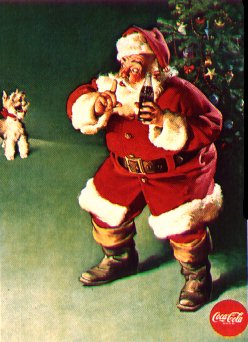|
|
A Brief History of Santa Claus
|
A Brief History of Christmas Cards
|
A Brief History of The Christmas Tree
|
A Brief History of Christmas Ornaments
|
Other Symbols and Customs of Christmas
|
Christmas Traditions in the United Kingdom
|
Christmas Traditions in Antebellum America
|
Christmas Traditions Around the World
|
Rudolph, the Red-Nosed Reindeer
Send E-Mail
|
Legal Notices
|
Other Links & Web Rings
|
Return to Title Page



|
Santa has not always appeared the way we think of him today. The first
well-known gift-giver was a true person--St. Nicholas. He lived in Myra (today
we know it as Turkey) in about 300 A.D. Born an only child of a wealthy family,
he was orphaned at an early age when both parents died of the plague. He grew
up in a monastery and at the age of 17 became one of the youngest priests ever.
Many stories are told of his generosity as he gave his wealth away in the form
of gifts to those in need, especially children. Legends tell of him either
dropping bags of gold down chimneys or throwing the bags through the windows
where they landed in the stockings hung from the fireplace to dry. Some years
later Nicholas became a bishop--hence the bishop's hat or miter, long flowing
gown, white beard and red cape. After his death he was elevated to sainthood.
Eventually the Catholic Church started celebrating Christmas and St. Nicholas
was incorporated into the season.
|
|
When the Reformation took place, the new Protestants no longer desired St.
Nicholas as their gift-giver as he was too closely tied to the Catholic Church.
Therefore, each country or region developed their own gift-giver. In France he
was known as Pere Noel. In England he was Father Christmas (always depicted
with sprigs of holly, ivy or mistletoe). Germany knew him as Dur Weihnachtsmann
(The Christmas Man). When the communists came to power in Russia and outlawed
Christianity, the Russians began to call him Grandfather Frost, who wore blue
instead of the traditional red. To the Dutch, he was Sinterklaas (which
eventually was mispronounced in America and became Santa Claus). These Santas
were arrayed in every color of the rainbow--sometimes even in black. But they
all had long white beards and carried gifts for the children.
|

|

|
The Santa we know today had his beginnings in 1823 with Clement C. Moore's "A
Visit from St. Nicholas" in which he described St. Nicholas as "chubby and
plump, a right jolly old elf". Forty years later, Thomas Nast, political
cartoonist, created a different illustration of Santa each year for the cover
of Harper's Weekly. His Santa was a plump, jolly old fellow with a white beard
and smoking a long stemmed pipe. During the Civil War, President Abraham
Lincoln asked Nast to do an illustration showing Santa with the Union troops.
Many historians say this was one of the most demoralizing moments for the
Confederate army....seeing Santa side with the North.
|
|
Finally, from 1931 to 1964, Haddon Sundblom created a new Santa each Christmas
for Coca-Cola advertisements that appeared world-wide on the back covers of
Post and National Geographic magazines. This is the Santa we know and love
today with a red suit trimmed with white fur, leather boots and belt, long
white beard and a pack of toys slung onto his back.
|

|
Click here to read Yes, Virginia, there is a Santa Claus.
For other examples of Victorian Santas on Christmas cards visit the Santa card page at Frederic Copeland, Esq. Stationers

A Brief History of Santa Claus
|
A Brief History of Christmas Cards
|
A Brief History of The Christmas Tree
|
A Brief History of Christmas Ornaments
|
Other Symbols and Customs of Christmas
|
Christmas Traditions in the United Kingdom
|
Christmas Traditions in Antebellum America
|
Christmas Traditions Around the World
|
Rudolph, the Red-Nosed Reindeer
Send E-Mail
|
Legal Notices
|
Other Links & Web Rings
|
Return to Title Page
|
|